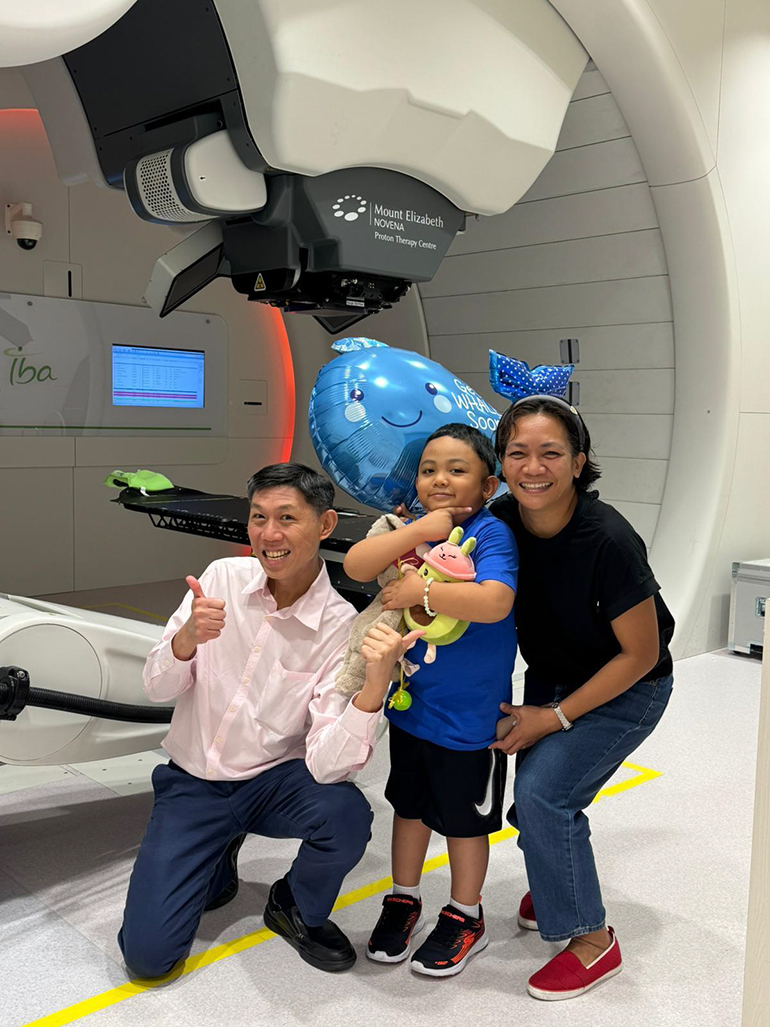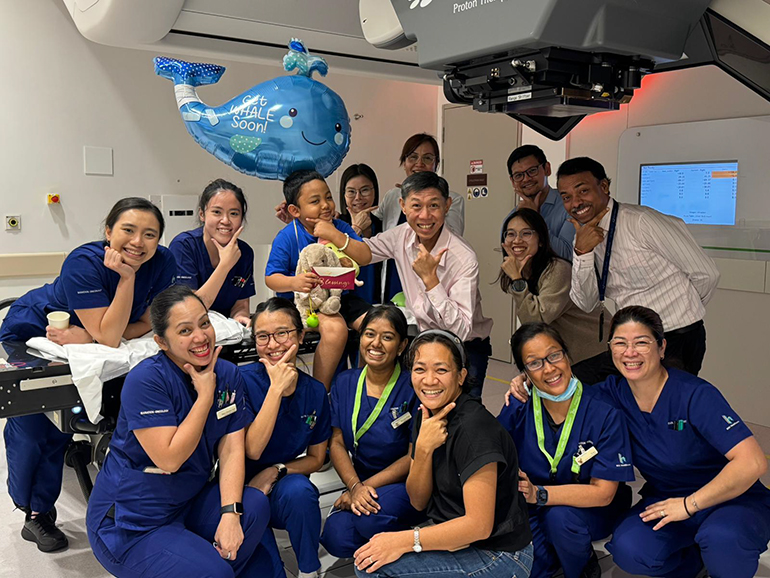
When four-year-old Ieuan Magat started bringing books close to his face, his mother, Roda Shane, assumed he needed glasses. What she did not expect was a doctor’s diagnosis revealing a craniopharyngioma, a rare brain tumor pressing against his optic nerves and threatening to take away his sight.
Roda sat in the hospital as doctors explained what that meant. The tumor came with a long list of complications, including vision loss and hormonal imbalance. Before his fifth birthday, Ieuan lost sight in his right eye.
She searched for hospitals beyond the Philippines, sending emails to medical centers around the world. Days passed with little to no response, until she heard back from Mount Elizabeth Novena Hospital in Singapore.
An answer far from home
At that time, Dr. Lee Kuo Ann, a radiation oncologist at the hospital, was visiting Manila for a medical lecture. A representative from IHH Healthcare Philippines showed him Ieuan’s scans. The doctor immediately saw the severity of the case.
“There was a large tumor pressing on the nerves of the eyes,” Dr. Lee said. “I recommended surgery [in the Philippines] followed by radiation therapy [in Singapore.]”
However, the public hospital system in the Philippines faced long waiting lists and limited access to advanced treatment. Ieuan had to wait ten months before surgery could be performed at the Philippine General Hospital. During that time, the tumor grew larger, further affecting his vision and sensation to temperature.
When surgery finally happened, doctors managed to reduce the tumor’s size, but the damage to his nerves could not be repaired.
“He asked why everything went black,” Roda told the media in Filipino. “I did not know how to answer.”
Despite that, Ieuan recovered faster than expected and remained cheerful throughout the process.
With arrangements made by Mount Elizabeth Novena Hospital, Roda and Ieuan flew to Singapore in August to begin advanced proton therapy, a precise type of radiation treatment that helps protect healthy tissues while targeting the tumor.
“Everything was already prepared when we arrived,” Roda said. “We were picked up from the airport and brought to the hotel. God is so good. Everything about our journey from Day 1 went smoothly.”
She added that the support from the medical team and hospital staff made a huge difference. Though her son could no longer see, she believed that the treatment gave him a better future and a chance to live without the constant threat of the tumor returning.
Roda said she hopes that more families in the Philippines can one day access advanced treatments like proton therapy. For now, she holds on to the hope that her son’s story will help others find strength, no matter how difficult the path may be.

Searching for the best treatment
Ieuan’s case became one of many where proton therapy provided a safer option for treating complicated brain tumors. Craniopharyngioma affects about two in every one million people and accounts for about 5% of childhood brain tumors. While benign, it can return after surgery and press on critical nerves.
“Because the tumor grows near sensitive areas in the brain, surgery alone may not be enough,” Dr. Lee said. “Traditional radiation can affect surrounding healthy brain tissue. For children, that can mean long-term complications such as lower IQ, memory loss, or developmental delays.”
Proton therapy offers an alternative that minimizes these risks. Instead of X-rays, it uses charged particles known as protons. These particles can release energy directly at the tumor site, preventing unnecessary exposure to surrounding areas.
“Proton therapy lets us target the tumor precisely, reducing damage to the rest of the brain,” Dr. Lee explained.
Ieuan’s tumor measured about six centimeters in diameter. Ieuan was in Singapore for more than a month and had 30 sessions of Proton Therapy. Each proton therapy session took about 30 to 45 minutes, though the actual proton radiation took less than two minutes. Most of the time was spent on precise tumour localisation by adjusting the equipment to make sure everything was perfectly aligned, since even small movements could affect results.
Dr. Lee explained that pencil-beam scanning treatment delivery method, one of the most advanced forms of proton therapy mode today, was used in Ieuan’s treatment. The method is available only in a few hospitals across Asia.
Dr. Lee and his team created a treatment plan specific to Ieuan’s case without damaging the rest of his developing brain. While Ieuan’s vision could not be restored, the treatment succeeded in stopping the tumor’s growth.
“With the radiation treatment, we can control the tumor about 85% of the time,” Dr. Lee said. “Control means the tumor shrinks or remains stable. Lack of control means it grows.”
For Roda, the journey was emotionally exhausting but worth it. Watching her son go through treatment was difficult, yet she found comfort in knowing Ieuan was receiving the best possible care.
Meanwhile, Dr. Lee noted that proton therapy is not a universal solution for all cancer cases. It is most effective for tumors located near vital organs or sensitive tissues where traditional radiation could cause severe side effects. In such cases, proton therapy allows doctors to treat the disease with greater precision and safety.
Singapore has become a regional destination for advanced cancer care, offering technology and expertise that attract families from across the globe. In May 2023, the country opened its first Proton Therapy Centre at Mount Elizabeth Novena Hospital, one of only two countries in Southeast Asia to offer proton beam therapy.
Since its launch, the Mount Elizabeth Proton Therapy Centre has treated patients from 29 countries. The youngest patient was just 1.5 years old, while the oldest was 87. The centre has established a strong reputation in managing head and neck cancers, brain cancers, and prostate cancers, which represent its top three treated cancer types.



